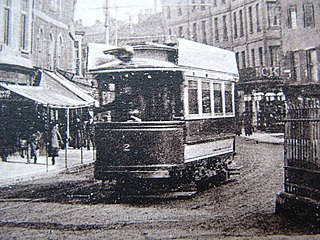
Llandudno is a seaside resort, town and community in Conwy County Borough, Wales, located on the Creuddyn peninsula, which protrudes into the Irish Sea. In the 2021 UK census, the community – which includes Gogarth, Penrhyn Bay, Craigside, Glanwydden, Penrhynside, and Bryn Pydew – had a population of 19,700. The town's name means "Church of Saint Tudno".

The Peak Tram is a funicular railway in Hong Kong, which carries both tourists and residents to the upper levels of Hong Kong Island. Running from Garden Road Admiralty to Victoria Peak via the Mid-Levels, it provides the most direct route and offers good views over the harbour and skyscrapers of Hong Kong. Operated since 1888, it was the first funicular railway in Asia.

The Great Orme is a limestone headland on the north coast of Wales, north-west of the town of Llandudno. Referred to as Cyngreawdr Fynydd by the 12th-century poet Gwalchmai ap Meilyr, its English name derives from the Old Norse word for sea serpent. The Little Orme, a smaller but very similar limestone headland, is on the eastern side of Llandudno Bay. The headland is a tourist attraction, with a Victorian tramway, a cableway, walking routes and a mining museum.

The Seaton Tramway is a 2 ft 9 in narrow gauge electric tramway in the East Devon district of South West England. The 3-mile (4.8 km) route runs alongside the Axe Estuary and the River Coly, running between the coastal resort of Seaton, the village of Colyford, and the ancient town of Colyton. For much of its route, it operates between the estuary and the Seaton Wetlands nature reserves, offering views of the wildlife of both.

The Great Orme Tramway is a cable-hauled 3 ft 6 in gauge tramway in Llandudno in north Wales. Open seasonally from late March to late October, it takes over 200,000 passengers each year from Llandudno Victoria Station to just below the summit of the Great Orme headland. From 1932 onwards it was known as the Great Orme Railway, reverting to its original name in 1977.

Transport in Wales is heavily influenced by the country's geography. Wales is predominantly hilly or mountainous, and the main settlements lie on the coasts of north and south Wales, while mid Wales and west Wales are lightly populated. The main transport corridors are east–west routes, many continuing eastwards into England.

Llandudno railway station serves the seaside town of Llandudno in North Wales. It is the terminus of a 3 miles (4.8 km) long branch line from Llandudno Junction on the North Wales Coast Line, between Crewe and Holyhead. The station is managed by Transport for Wales Rail, who operate all trains serving it. Llandudno Victoria station, the lower terminus of the Great Orme Tramway, is a 15-minute walk from the main station.

The Howth Tram on the Hill of Howth Tramway was a tram which served Howth Head, near Dublin, Ireland. The termini were at Sutton railway station, by the entrance to the peninsula, and Howth railway station by the village and harbour of Howth.

Nottingham and District Tramways Company Limited was a tramway operator from 1875 to 1897 based in Nottingham in the United Kingdom.

The Bordeaux tramway network consists of four lines serving the city of Bordeaux in Nouvelle-Aquitaine in southwestern France. The system has a route length of 77.5 kilometres (48.2 mi), serving a total of 133 tram stops.

The Strasbourg tramway, run by the CTS, is a network of six tramlines, A, B, C, D, E and F that operate in the cities of Strasbourg in Alsace, France, and Kehl in Baden-Württemberg, Germany. It is one of the few tram networks to cross an international border, along with the trams of Basel, Geneva and Saarbrücken. The first tramline in Strasbourg, which was originally horse-drawn, opened in 1878. After 1894, when an electric-powered tram system was introduced, a widespread network of tramways was built, including several longer-distance lines on both sides of the Rhine.

Reims tramway is a tram system in the French city of Reims, which opened in April 2011. It travels north to south, through the city, along 11.2 kilometres (7.0 mi) of route.

Pessac Centre tram stop is the terminus of the Pessac Centre branch of line B of the Bordeaux tramway, and is located on Avenue Eugène et Marc Dulout in the centre of the commune of Pessac. The tram stop is adjacent to Pessac railway station, with direct access between station and tram stop platforms, and the Mairie de Pessac.

Hurst, Nelson and Company Ltd was a railway rolling stock manufacturer based in Motherwell, Scotland. The company also built many railway wagons, as well as trams and trolleybus carosseries for several local authorities.
Halfway tram stop may refer to:

The Taunton Tramway was an electric street tramway in Taunton, the county town of Somerset, England. It operated a fleet of six narrow gauge tramcars on a single route of 1.66 miles (2.67 km) between 1901 and 1921 when the tramway closed due to a dispute over the cost of electricity.

The Llandudno Cable Car is an attraction in the seaside resort of Llandudno in Conwy County Borough, Wales. The cable car runs along the Great Orme spanning a distance of one mile forty feet (1.622 km) exactly. The cable car was opened in summer 1969, and has been operational ever since. The cabins give views of the Irish Sea looking over to Rhyl and the Isle of Man, as well as the Snowdonia National Park. There are currently 20 cabins in service, which leave each station at approximately one-minute intervals. The cabins are painted in red, yellow, orange, light blue and purple. The cable car is now owned by Kinetics Industrial Ltd. The highest point from the ground is around 80 feet (24.38 m). Nine pylons support the cable.

Llandudno Victoria tram stop is the lower terminus of the Great Orme Tramway, situated in the centre of the town of Llandudno, Wales. The Great Orme Tramway is a funicular, which connects this terminus to the Halfway and Summit stops on the Great Orme.

The Halfway tram stop is a tram stop situated at the midpoint of the Great Orme Tramway on the slopes of the Great Orme in Llandudno, Wales. The Great Orme Tramway operates as a two-section funicular, and passengers must change at Halfway between the lower section and the upper section. The stop is also convenient for the nearby Bronze Age Copper Mines.

The Seaton tramway station is the southern terminus of the Seaton Tramway. The station is situated in the town centre of the town of Seaton in the English county of Devon. The terminus at Seaton opened in 1975, and has since been entirely rebuilt twice. The most recent rebuilding has resulted in the construction of a modern enclosed building suitable for operation all-year round, and which acts as a venue for a range of tramway and community based events.




















